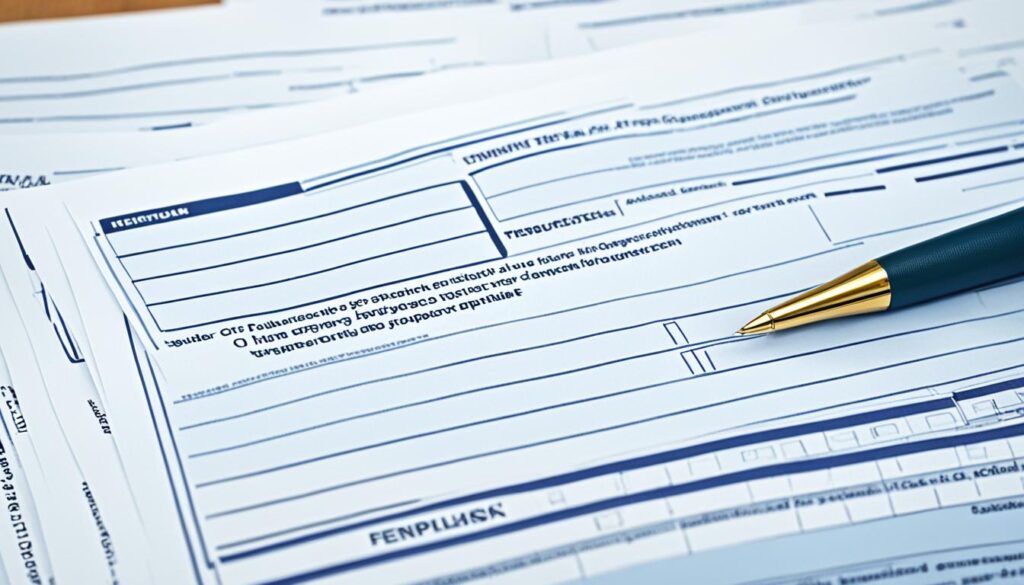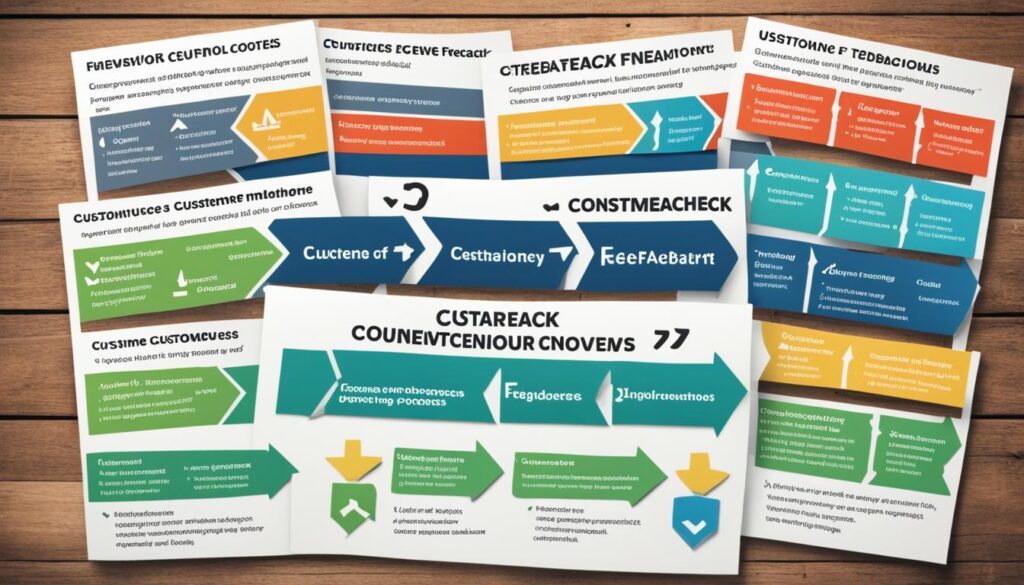Welcome to our guide on mastering the customer feedback loop. In today’s competitive business landscape, gathering and utilizing customer feedback is essential for improving your products and enhancing the overall customer experience. By implementing an effective feedback loop, you can unlock valuable insights to boost customer satisfaction and drive business success.
But what exactly is a customer feedback loop? It’s a continuous process of collecting feedback from your customers and using that feedback to make informed decisions and improvements. By engaging with your customers at every stage of their journey, you can gain valuable insights into their needs, preferences, and pain points.
In this article, we will explore how continuous feedback loops can enhance your product, the best ways to collect customer feedback, and how to engage customers through surveys. We will also cover the importance of building and testing early-stage ideas, measuring and collecting customer feedback, and other methods for effective customer feedback loops. Finally, we’ll discuss how to prioritize feedback, store it, define processes and workflows, and the benefits of implementing a customer feedback loop.
So, if you’re ready to optimize your feedback loop, improve customer satisfaction, and enhance the overall customer experience, let’s dive in and master the customer feedback loop process!
What are Feedback Loops and Why Should You Use Them?
Feedback loops play a crucial role in continuously collecting customer feedback and leveraging those insights to improve your product. This iterative process, often referred to as the build-measure-learn process, is fundamental to the Lean Startup methodology pioneered by Eric Ries.
By implementing feedback loops, you enable your company to gather ongoing product feedback, understand customer needs, and make necessary improvements. These loops allow you to adapt and evolve your product based on real-time customer insights, ultimately creating a product that resonates with your target audience.
“Feedback loops are the key to unlocking innovation and achieving customer satisfaction. They provide a direct line of communication between your customers and your product development team, allowing you to address their pain points and deliver the best possible product experience.”
To illustrate the importance of feedback loops, let’s take a closer look at the build-measure-learn process. This iterative approach involves building a minimum viable product (MVP), measuring customer response to that product, and learning from the data collected. By analyzing customer feedback, you gain valuable insights into product usability, customer preferences, and areas for improvement.
The build-measure-learn process forms the foundation for effective feedback loops. With each iteration, you incorporate customer feedback into your product development cycle, ensuring that your product continuously evolves and aligns with your customers’ needs and expectations.
Feedback loops are not a one-time activity but an ongoing process. By embracing customer feedback and actively seeking out product feedback through surveys, interviews, and other channels, you can build a strong feedback loop that fosters continual improvement.
The Benefits of Feedback Loops
The benefits of implementing feedback loops are significant. By using feedback loops, you can:
- Gain valuable insights into customer needs and preferences.
- Identify areas for product improvement and innovation.
- Enhance customer satisfaction and loyalty.
- Develop a product that meets customer expectations.
- Stay ahead of the competition in a rapidly changing market.
Feedback loops empower you to create products that your customers love, resulting in increased customer satisfaction and long-term business success.
Now that we understand the importance of feedback loops and how they contribute to product development, let’s dive deeper into the strategies for building and testing early-stage ideas.
Building and Testing Early-Stage Ideas
Building and testing early-stage ideas is a critical step in the feedback loop process. It allows you to gather valuable insights quickly and efficiently, ensuring that your product aligns with customer expectations. To effectively build and test your ideas, consider implementing the following strategies:
1. Brochures and Datasheets
Creating brochures and datasheets can help you present your idea visually and concisely. These marketing materials act as a tangible representation of your product vision, allowing potential customers to understand its key features and benefits. By sharing these materials, you can gather initial feedback and gauge customer interest.
2. UI Mockups
Designing user interface (UI) mockups provides a visual representation of your product’s interface and functionality. It helps stakeholders and potential customers visualize how the final product will look and function. Collecting feedback on UI mockups allows you to identify any usability issues early on and make necessary improvements before investing significant time and resources in development.
3. Prototypes
Developing prototypes is a crucial step in testing the functionality and feasibility of your early-stage ideas. Prototypes can range from low-fidelity paper prototypes to interactive digital prototypes. They allow you to simulate the user experience and gather feedback on the overall usability, design, and functionality of your product. By involving users early in the process, you can identify potential flaws and make iterative improvements.
Remember that the goal of building and testing early-stage ideas is to create something tangible that you can put in front of users. This approach enables you to start collecting valuable feedback and insights right away, helping you refine your product in line with customer needs and preferences.

Now that you have a clearer understanding of how to build and test your early-stage ideas, let’s move on to the next section discussing different methods for measuring and collecting customer feedback.
Measuring and Collecting Customer Feedback
When it comes to understanding your customers’ needs and preferences, customer interviews and surveys are invaluable tools. Customer interviews allow you to dive deep into their experiences, uncovering valuable insights into their problems, desires, and the solutions they are seeking.
In addition to interviews, surveys provide quantitative data on customer experiences, allowing you to gather feedback at scale. One popular survey method is the Net Promoter Score (NPS) survey, which measures customer loyalty and likelihood of recommending your product or service. The Customer Satisfaction (CSAT) survey measures overall satisfaction with specific interactions, while the Customer Effort Score (CES) survey evaluates the ease of use and efficiency of your product.
By combining customer interviews and surveys, you can gain a comprehensive understanding of your customers’ needs, satisfaction levels, and areas for improvement. This data-driven approach ensures you make informed decisions and prioritize product enhancements that align with your customers’ expectations.
Customer interviews and surveys empower you to capture both qualitative and quantitative feedback, providing a holistic view of your customers’ experiences and driving customer-centric improvements.
To illustrate the value of customer feedback, let’s consider an example: a software company wants to enhance its user interface to improve usability. By conducting customer interviews, they uncover pain points and specific areas where users struggle. This qualitative feedback helps the company refine their design and address the most pressing user needs.
On the other hand, a CSAT survey reveals that customers are generally satisfied with the software but find certain features confusing. Armed with this quantitative data, the company can focus their efforts on enhancing those features to further improve customer satisfaction.
Customer interviews and surveys are not only effective tools for gathering feedback, but they also foster a sense of customer engagement and validation. When customers see that their opinions matter and their feedback is being used to drive product improvements, they are more likely to feel valued and develop a stronger connection with your brand.
To enhance this section, let’s include an image that reflects the importance of customer interviews and surveys in the feedback collection process:

In the image above, you can see a sample customer satisfaction survey, one of the many types of surveys commonly used to collect customer feedback.
Other Methods for Effective Customer Feedback Loops
In addition to customer interviews and surveys, there are several other methods you can utilize to build effective customer feedback loops. These methods allow you to gain valuable insights and enhance your understanding of customer needs and preferences.
Product Betas
Product betas offer a unique opportunity to involve your target users in the development process. By allowing them to test the functionality of your product before its official launch, you can receive valuable feedback and identify areas for improvement. Product betas empower your users to become an integral part of the product development journey and ensure that it meets their expectations.
Digital Experience Analytics
Digital experience analytics tools, such as FullStory, provide comprehensive insights into user behavior and interactions. By capturing user sessions, you can gain a deeper understanding of how your customers navigate and engage with your product. These insights allow you to identify pain points, optimize user experience, and make data-driven decisions to enhance overall satisfaction.
Customer Support Feedback
“Our customer support teams play a vital role in gathering feedback based on their direct interactions with customers. They can uncover valuable insights into customer pain points, challenges, and suggestions for improvement. By leveraging this frontline feedback, you can effectively address customer needs and enhance their overall experience.” – Sarah Johnson, Customer Support Manager at XYZ Company
Product Usage Metrics
Collecting and analyzing product usage metrics provide valuable insights into how customers interact with your product. By monitoring metrics such as user engagement, feature adoption, and retention rates, you can identify areas of improvement and prioritize product enhancements. These metrics help you make data-driven decisions and continuously optimize your product based on real user behavior patterns.
Input from Sales and Employees
Your sales team and employees are valuable sources of feedback. They interact with customers on various levels and have insights into customer pain points, frequently asked questions, and suggestions for improvement. Encouraging open communication channels with your sales team and employees allows you to capture their valuable perspectives and integrate them into your feedback loop process.
Continuous Improvement and Feedback Management
To ensure continuous improvement, it is essential to prioritize feedback, determine where to store it, and establish effective processes and workflows. By implementing a robust feedback management system, you can leverage customer insights to drive meaningful enhancements in your product or service.
Prioritize Feedback
Not all feedback is equal. It is crucial to differentiate between valuable insights and noise. Take the time to identify the main sources of feedback, such as in-app surveys, email surveys, customer interviews, or support requests. By focusing on high-impact feedback, you can allocate your resources and attention more effectively.
Feedback Storage
Centralizing feedback is vital for easy access and analysis. Consider using a dedicated product management platform like Productboard, where you can create a centralized repository for all feedback and ideas. This allows you to organize and categorize feedback, making it easier to identify patterns and prioritize improvements.
Define Processes and Workflows
A well-defined feedback loop process ensures that feedback is consistently collected, analyzed, and acted upon. Establish clear guidelines and workflows for how feedback is handled within your organization. This includes assigning responsibilities, setting timelines, and creating accountability to ensure that customer insights are not overlooked or delayed.
“Customer feedback is the lifeblood of any successful business. Prioritize it, store it effectively, and define your processes and workflows to drive continuous improvements based on customer insights.”
To gain a deeper understanding of the importance of feedback management, refer to the image below:

Continue reading to explore the benefits of implementing a customer feedback loop in Section 7.
Customer Feedback Loop Benefits
Implementing a customer feedback loop has numerous benefits for your business. By keeping your customers happy and addressing their needs, you can increase customer loyalty, leading to repeat business and positive word-of-mouth referrals. Satisfied customers are more likely to become advocates for your brand. Studies show that even a 5% increase in customer loyalty can result in a 75% increase in profitability. Collecting and utilizing customer feedback is a key driver of business success.

“A satisfied customer is the best business strategy of all.”
– Michael LeBoeuf
In today’s competitive business landscape, customer satisfaction is paramount. Listening to your customers and acting on their feedback builds a strong foundation of trust and fosters long-term relationships.
How Customer Feedback Drives Loyalty and Advocacy
- Improved customer experience: By actively seeking and implementing customer feedback, you can enhance your products, services, and overall customer experience, leading to increased satisfaction and loyalty.
- Personalized offerings: Understanding your customers’ preferences and needs through feedback enables you to tailor your offerings, making them more relevant and valuable to individuals.
- Responsive customer support: Addressing customer concerns and issues promptly demonstrates your commitment to their satisfaction and builds trust in your brand.
- Positive word-of-mouth: Satisfied customers are more likely to share their positive experiences with others, generating organic referrals and expanding your customer base.
When you prioritize customer feedback, you show your customers that their opinions matter and that you value their input. By implementing their suggestions and resolving their pain points, you create a positive feedback loop that strengthens customer loyalty and advocacy for your brand.
Driving Profitability Through Customer Feedback
Customer loyalty and advocacy directly impact your bottom line. When customers are satisfied and loyal, they are more likely to:
- Make repeat purchases, contributing to increased sales and revenue.
- Refer your brand to others, resulting in new customer acquisitions at a lower cost.
- Choose your brand over competitors, reducing customer churn.
- Provide valuable feedback and insights, helping you identify new opportunities for growth and improvement.
By continuously collecting and analyzing customer feedback, you can identify areas where you can enhance customer satisfaction and loyalty, ultimately leading to increased profitability for your business.
Implementing a customer feedback loop is not just about listening to your customers; it is about taking action based on their feedback. By incorporating their insights and suggestions into your decision-making processes, you demonstrate your commitment to their needs and continuously strive to improve their experience with your brand.
Conclusion
Creating a customer feedback loop is vital to optimizing your product and enhancing customer satisfaction and experience. By actively collecting feedback, analyzing data, and continuously making improvements, you can develop a product that truly meets the needs of your customers and fosters loyalty.
Remember, the feedback loop should be an ongoing process, integrated into your company culture. Regularly seek feedback from your customers through surveys, interviews, and other methods to gather valuable insights. Analyze the data collected and use it to inform your product decisions and improvements.
Through this iterative process, you can optimize your feedback loop and ensure that your product is constantly evolving to exceed customer expectations. By placing a strong emphasis on customer feedback, you can enhance the overall experience and satisfaction, leading to increased loyalty and positive word-of-mouth referrals.
Ultimately, by prioritizing feedback and taking action on it, you can create a product that not only meets but exceeds the expectations of your customers. Embracing a customer-centric approach and incorporating feedback into your product development process will set you on the path to long-term success.
FAQ
What is a customer feedback loop?
A customer feedback loop is the process of continuously collecting customer feedback and using it to improve your product or service.
Why is a customer feedback loop important?
A customer feedback loop is important because it enables you to gather valuable insights from your customers and make necessary improvements to your product or service based on their feedback.
How can I build and test early-stage ideas?
You can build and test early-stage ideas by creating brochures, datasheets, UI mockups, and prototypes to gather user feedback and evaluate the viability of your product or service.
What are effective methods for collecting customer feedback?
Effective methods for collecting customer feedback include conducting customer interviews to gain in-depth insights and utilizing surveys such as NPS surveys, CSAT surveys, and CES surveys for quantitative data on customer experiences.
What are some other methods for effective customer feedback loops?
Other methods for effective customer feedback loops include running product betas to allow target users to provide feedback, using digital experience analytics tools to gain insights from user sessions, and leveraging feedback from customer support teams, sales teams, and employees.
How can I manage and prioritize customer feedback?
You can manage and prioritize customer feedback by identifying the main sources of feedback, using a product management platform to centralize all feedback, and establishing clear processes and workflows for analyzing and acting on customer insights.
What are the benefits of implementing a customer feedback loop?
Implementing a customer feedback loop can lead to increased customer loyalty, positive word-of-mouth referrals, and higher profitability for your business.
How can a customer feedback loop optimize my product and improve customer satisfaction?
A customer feedback loop allows you to continuously gather feedback and make improvements based on customer insights, helping you build a product that meets customer needs and enhances their overall satisfaction.
